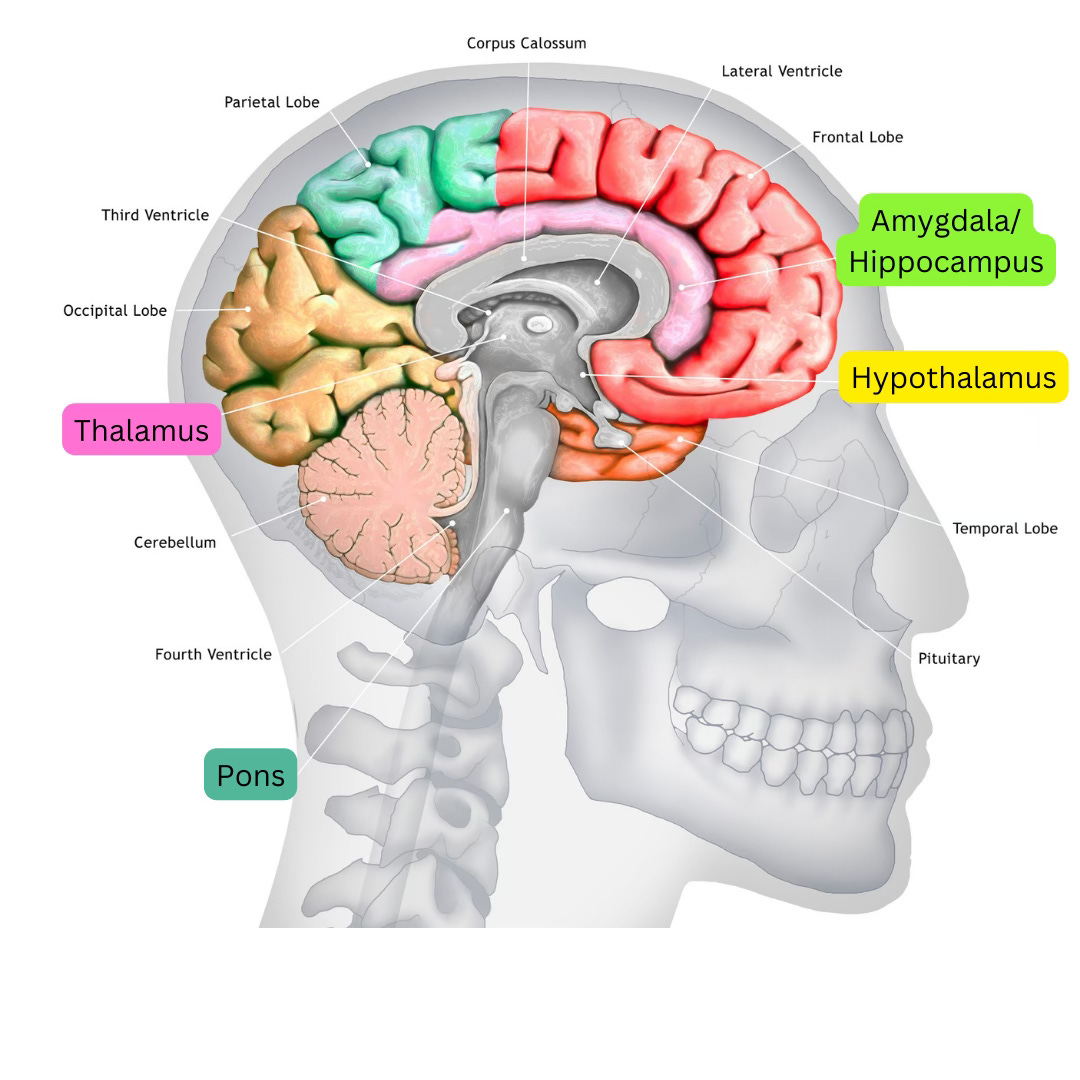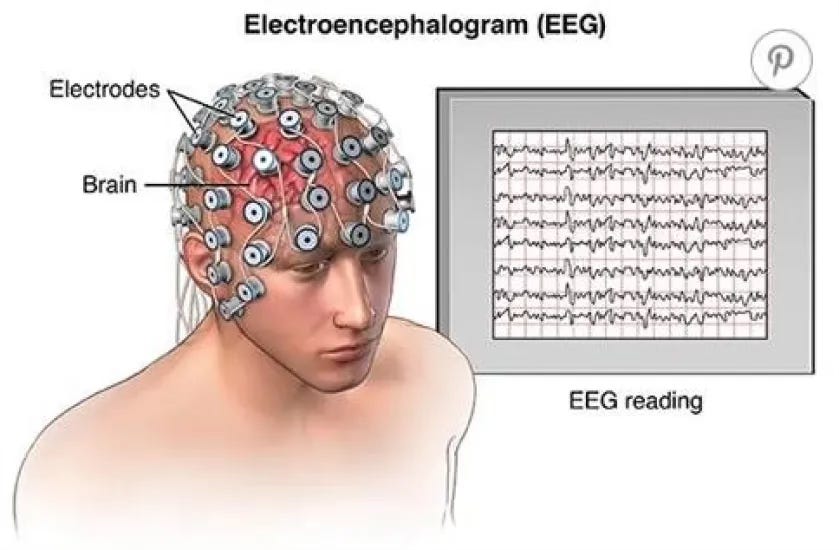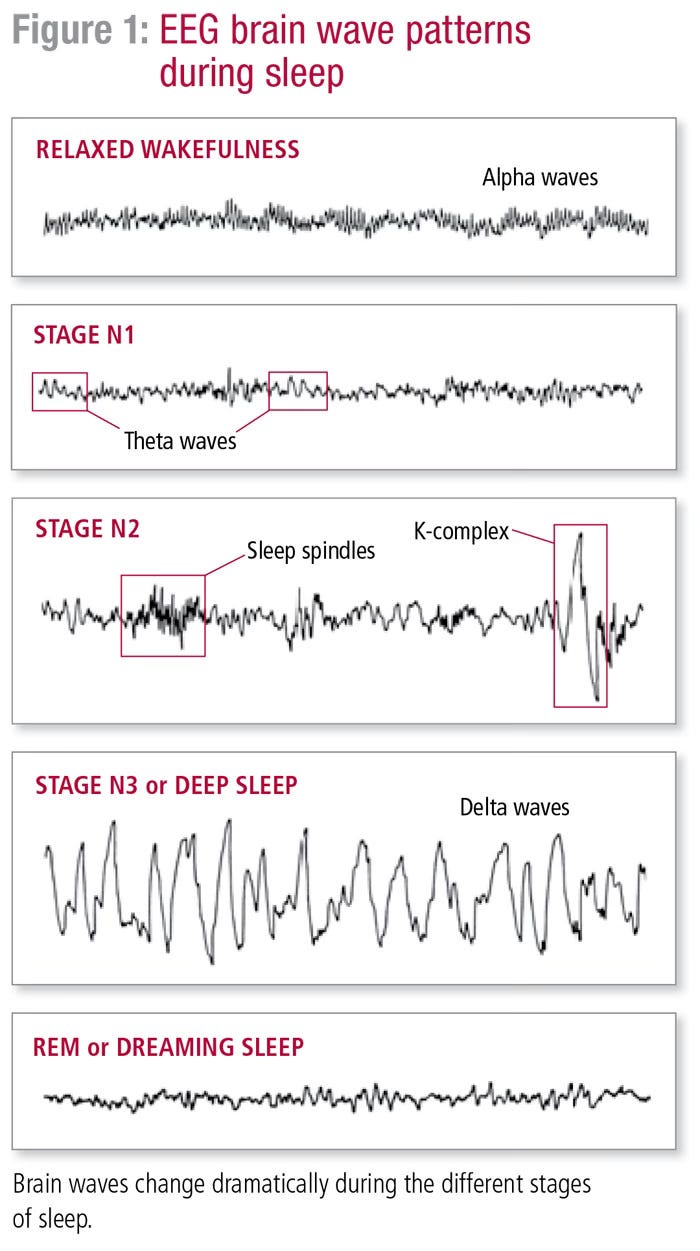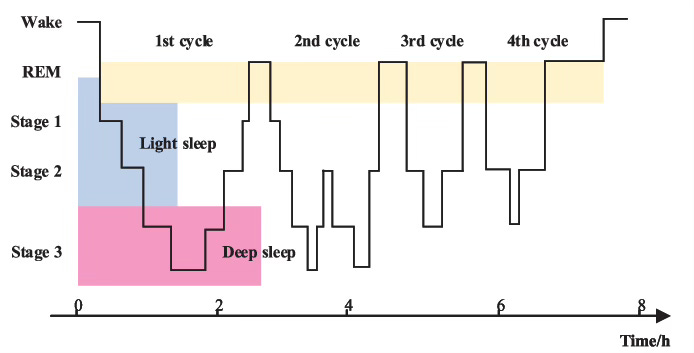In a previous article, I delved into the connection between deep sleep and learning. This time, I aim to simplify the science of sleep. Instead of listing tips to promote better sleep, I’ll explore the science behind sleep physiology so you can discern the good advice from the bad.
Lately, I've been using my Apple Watch to track my sleep at night. In the morning, I can see a diagram showing the time spent in REM and NREM sleep, as well as the number of sleep cycles. I've become quite obsessed with it. This made me wonder if I know enough about sleep science!
But first… some Anatomy
Parts of our brain involved in sleep
Below is a diagram showing the inside of our brain. It has many complicated parts, one of which is the limbic system (all the highlights below).
The hypothalamus (yellow highlight) controls the onset of sleep.
The hippocampus and Amygdala are the regions active for memory and emotion during dreaming (green highlight).
The Thalamus is responsible for preventing sensory stimuli from reaching the cortex (pink highlight).
The pons, a region of the brainstem, initiates REM sleep. REM stands for Rapid Eye Movements. The eye movements seen during REM sleep occur because of stimulation of nerve fibres in this region.
The mechanism of sleep
REM, NREM, Slow Wave Sleep… these terms have originated from experiments done on individuals who volunteered to have their brain imaged using a machine while they slept. Have you ever seen or had an ECG done? Leads are placed on your chest at regular intervals and an electrical tracing of the heart activity appears on a piece of paper.
Imagine the same, but for the brain- that’s what an EEG, or electroencephalogram looks like.
When looking at an EEG, you may notice different waveforms. We have noticed that a specific waveform is most common in each sleep stage, and as one goes into a deeper sleep, the waveform changes. They somewhat resemble the waves in the image below:
Sleep occurs in five stages. Lets walk you through it (or shall I say, sleep you through it?)
1. Wakefulness (Stage W)
In this stage, you have just lied down in bed, the lights are off, and you have closed your eyes. Your breathing is regular, and you feel relaxed.
Your EEG here would show “relaxed alpha waves”
2. Light sleep (NREM 1 or N1 Non Rapid Eye Movement 1)
Here, the alpha waves begin to switch to theta waves. You still have some tone in the muscles of your body, and your breathing is still regular. In this stage, you might feel muscle twitches or jerks. I have often experienced a sensation of “falling” during this stage. These are normal occurences, and although we dont know where they come from, we know not to worry about them.
This stage is short lasting- about 1-5 minutes and ought to be 5% of your total sleep time. If it is more, it means that there were multiple episodes of transition between wakefullness and sleep, meaning you were probably disturbed or awoken during your sleep!
3. Deeper sleep (NREM 2 or N2)
Your EEG here would show sleep spindles and K complexes as your body temperature begins to drop and your heart rate slows down. Many are known to grind their teeth during their sleep. If they do, its most likely to occur during this stage!
This stage initially lasts for about half an hour in the first cycle. However, with each cycle, the length of this stage prolongs such that overall, it forms 50% of your total sleep time!
Some of you might wonder where these waves come from and why they look like spindles or K complexes. Its difficult to answer that question. All we know is that when we see, for example, k complexes on an EEG we can say with certainty that the individual is in stage N2.
4. Deepest sleep (NREM 3 or N3)
Delta waves, or waves with low frequencies and high amplitudes occur here. This stage is also known as Slow Wave Sleep because, if you observe the diagram, the waves look like they are taking forever to progress compared to alpha, or even theta waves. We spend a lot of time in this phase during the initial cycles, but as the night progresses, this duration shortens and we might not enter the deepest stage of sleep during the last few!
This is the stage that is the most difficult to wake someone up from. It’s also the stage in which you MUST paint the sleeping individual’s face, haha!
Here, the body is repairing itself and building its immunity. Its also the stage in which sleepwalking and night terrors occur :(
5. REM sleep
Finally, we come to the strangest of all stages (according to me). During REM sleep, the waves are known as beta waves but are very similar to alpha waves (the waves of wakefulness).
While in this stage, a person’s eyes have been observed to move rapidly, thus the name- Rapid Eye Movement (REM). Dreaming occurs in this stage, and the brain has been evidenced to be highly active.
The exact function of this stage is still unknown. We dont know how useful it is to spend time in REM sleep during the sleep cycles.
I really liked this image which I found on the Unisom website. However, I have not tried any of their products. Only mentioning them so that I don’t get into trouble for using their artwork!
We cycle at night
Our sleep pattern is such that we progress through the above stages repeatedly, in a pattern called a sleep cycle.
We start with N1, progress to N2, N3, then REM and move on to N1 again. Typically, we go through 4-5 cycles per night.
The duration that we spend in each stage also changes as the night progresses. For example, we don’t spend too much time in the REM stage in the first cycle but as the night progresses that increases to almost 30% of the entire cycle.
Do we need sleep?
Believe it or not, one of the greatest mysteries is the usefullness of sleep. Do we really need it? You know you feel terrible if you havent had a good nights sleep. However, we dont know what actually occurs during sleep. Is there neuron regeneration? Memory consolidation? Muscle repair in the limbs?
We need experiements and animal models to tell us for sure. In 2013, a paper was published by researchers in New York who studied live mice and their brains after sleep. They were able to link their findings to the possibility that there is neurotoxic waste product clearance that occurs overnight.
From subjective experience and observation of sleep deprived individuals we know that a lack of sleep affects mood, cognition, memory, and can impact health and immunity. Research into the importance of sleep, and the purpose of each stage is ongoing.
Phew! That’s a lot of science!
I absolutely loved writing this article. I did not know SO MUCH about sleep! However, during my research I discovered that the world of sleep is deep (pun intended).
There is so much more I could cover, however I choose not to. If any part of this article piqued your interest enough to want to know more- let me know! Im happy to dive straight into it and write a whole other article based on that.
To summarise what we have just read:
We started off by reading a little bit about the Anatomy of the brain. Then, we stepped into the sleep cycle and what all the funny terms REM and NREM mean! Finally, importance of sleep was discussed.
Top Tip
If you struggle with sleep, the worst thing to do is overthink it. Submit to relaxing your body and mind and commit to a night of rest. Whether sleep arrives or no is OUT of your control!
Happy Reading :)









